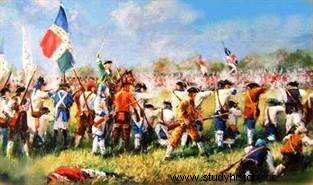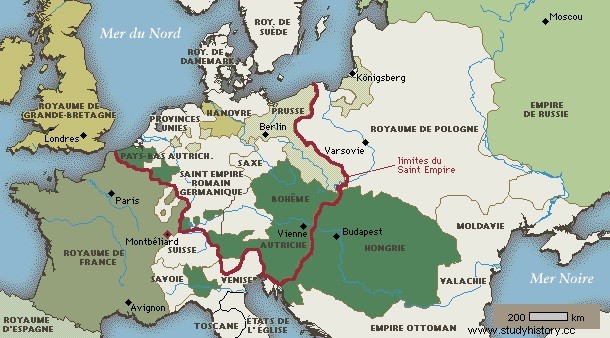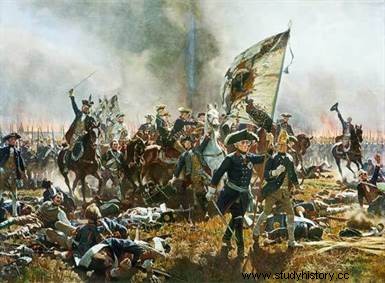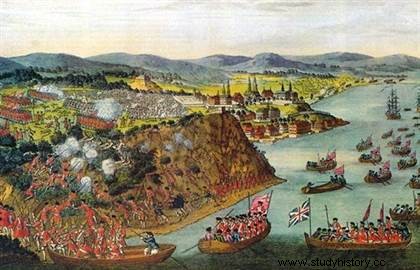 The Seven Years' War is a conflict which lasted from 1756 to 1763 and which opposed on the one hand France and England in their colonial ambitions, and on the other hand Prussia and Austria. Following a “reversal of alliances”, the French armies, which had become allies of the Austrians, found themselves engaged both at sea and on the continent. This first "world war" which takes place in Europe and on all the seas of the globe, from the Antilles to India, begins with the successes of Montcalm in Canada before turning into a fiasco. At the end of the Seven Years' War, the France of Louis XV lost almost all of its first colonial empire and Prussia asserted itself as a great European power.
The Seven Years' War is a conflict which lasted from 1756 to 1763 and which opposed on the one hand France and England in their colonial ambitions, and on the other hand Prussia and Austria. Following a “reversal of alliances”, the French armies, which had become allies of the Austrians, found themselves engaged both at sea and on the continent. This first "world war" which takes place in Europe and on all the seas of the globe, from the Antilles to India, begins with the successes of Montcalm in Canada before turning into a fiasco. At the end of the Seven Years' War, the France of Louis XV lost almost all of its first colonial empire and Prussia asserted itself as a great European power.
The Seven Years' War, the first global conflict
The peace established at the end of the War of the Austrian Succession had left all the belligerents unsatisfied. The peace concluded at the Treaty of Aix-la-Chapelle in 1748 had only been of short duration, and it had only been a truce in the conflict between the European powers. Hostilities would resume in 1756 and last seven years. But since the War of the Austrian Succession, relations between nations had evolved and the reversal of alliances had transformed relations between states. The European crisis that began in 1756 had in fact two main reasons:the maritime and colonial rivalry opposed France and England in North America and India; Austria's concern over Prussia's progress and Maria Theresa's desire to retake Silesia from Frederick II.
Since the 17th century, the French had penetrated into the interior of Canada and possessed, from the St. Lawrence to the Mississippi, a very vast territory. They had built forts in the Ohio valley to block the way to the English, who had military forces superior to theirs. The struggle began in earnest after the Treaty of Aix-la-Chapelle along the course of the Ohio. In 1754, militiamen from Virginia, commanded by young George Washington, killed a French officer, Jumonville, in obscure conditions, and the French retaliated by taking Fort Necessity, where the British colonists were stationed.
The following year, on June 10, 1755, two French vessels, the Alcide and the Lys, victims of the "Boscawen attack", were captured near the benches of Newfoundland by the English. Shortly afterwards, three hundred French ships and their cargoes estimated at 30 million were taken by English privateers. But, while England was actively preparing to fight, Louis XV was reluctant to accept a war that he found repugnant.
1756:the reversal of alliances
England was preoccupied with building alliances in Europe. On January 16, 1756, Frederick of Prussia concluded a military guarantee agreement with the British sovereign George II. This treaty caused the rupture between Prussia and France and, fearing to find himself isolated in front of a coalition directed against him, Louis XV decided to accept the proposals for an agreement made to him for several years by Marie-Thérèse of Austria. The ambassador of the latter, Kaunitz, had known how to gain the confidence of Madame de Pompadour, who had instructed her friend, the Abbé de Bernis, to negotiate with Austria.
 On May 1, 1756, a treaty was signed at Versailles, by which the two nations pledged to assist each other. Then, on January 11, 1757, by signing the Convention of Saint Petersburg, Tsarina Elizabeth acceded to this treaty but obtained the consent of Louis XV to the crossing of Poland by his troops. This reversal of alliances strongly shocked French public opinion, which had always been hostile to the House of Austria and, on the other hand, full of sympathy for Frederick of Prussia, who still remained the "enlightened despot" appreciated by philosophers.
On May 1, 1756, a treaty was signed at Versailles, by which the two nations pledged to assist each other. Then, on January 11, 1757, by signing the Convention of Saint Petersburg, Tsarina Elizabeth acceded to this treaty but obtained the consent of Louis XV to the crossing of Poland by his troops. This reversal of alliances strongly shocked French public opinion, which had always been hostile to the House of Austria and, on the other hand, full of sympathy for Frederick of Prussia, who still remained the "enlightened despot" appreciated by philosophers.
Thanks to the reversal of the alliances, France and Austria were now allies and obtained the support of the Empress of Russia, the King of Sweden, the Elector of Saxony and most of the German princes. In order to prevent the effects of this coalition, Frederick II took the initiative and threw himself on Saxony in August 1756. From then on, two wars were going to take place simultaneously, one between Prussia and the European coalition in Germany and on the borders of Bohemia and Poland, and on the other at sea and in the colonies between France and England.
Seven Years' War:successes and setbacks
The first clashes at sea were favorable to France. After setting sail from Toulon on April 12, 1756, the French squadron, under the command of La Galissonière, arrived in Menorca and defeated the English Admiral Byng's fleet, which enabled Marshal Richelieu to seize the Port. -Mahon, a famously impregnable place.
But these victories which deprived the English of control of the Mediterranean had only a momentary effect, because, in the years that followed, the English fleet regained the advantage over the coasts of France and inflicted heavy defeats on French ships, particularly at Quiberon, where, in 1759, Admiral de Conflans was defeated by Admiral Hawke.
On the continent, Frederick of Prussia, deprived of the help of England, which had devoted its forces to the fight at sea, found himself alone against the allied armies. With his army of around 150,000 men, he took the initiative in Bohemia and Saxony by trying to prevent the junction between the troops of Maria Theresa and those of the Elector of Saxony. But the war began with a series of defeats for the King of Prussia and his allies:defeated at Kolin on June 18, 1757, Frederick had to evacuate Bohemia, while East Prussia was invaded by Russia and Pomerania by the Swedes. The French had entered Westphalia. Marshal de Richelieu occupied Hanover and forced the Anglo-Hanoverian army of the Duke of Cumberland to sign the capitulation of Kloster-Zeven (September 8, 1757). However, Richelieu did not take advantage of his advantage and contented himself with subjecting the country to regulated looting, which earned him the unflattering nickname of "Père la Maraude".
Frederic II of Prussia wins with difficulty in Europe
 Frederic II knew how to take advantage of a situation that seemed hopeless for him:on November 5, 1757, he beat at Rossbach a German army commanded by the incompetent Marshal de Soubise, favorite of Louis XV. Soubise became the laughingstock of the French who harshly mocked his defeat:“Soubise said, lantern in hand, I’m looking for it! Where is my army? She was there yesterday morning though! .
Frederic II knew how to take advantage of a situation that seemed hopeless for him:on November 5, 1757, he beat at Rossbach a German army commanded by the incompetent Marshal de Soubise, favorite of Louis XV. Soubise became the laughingstock of the French who harshly mocked his defeat:“Soubise said, lantern in hand, I’m looking for it! Where is my army? She was there yesterday morning though! .
Two months later, Frederick of Prussia dispersed the Austrians at Leuthen in Silesia. During the years that followed, the Prussian king had to face, on three different fronts, three groups of armies which converged on Berlin. The French were defeated at Krefeld in June 1758 and lost Hanover, which could not be recaptured, despite the efforts of Marshal de Broglie. A year later, in August 1759, they were again defeated at Minden.
But soon Prussia succumbed to the coalition forces closing in around her. On August 12, 1759, the Austro-Russians defeated him at Kunersdorf and entered Berlin in October 1760. The Imperials occupied Saxony and the Austrians Silesia. France itself won a victory at Clostercamp on October 15, 1760, and this battle was illustrated by an act of courage reported by Voltaire:the young Chevalier d'Assas fell, during the night preceding the battle, on a column enemy who surrounded him and threatened him with death if he warned the French.
But Assas did not hesitate to save his compatriots by shouting to his regiment:"Our enemies, Auvergne, are ours!" and fell, pierced with blows. But, despite other glorious episodes such as the taking of Cassel by the Comte de Broglie or the victorious defense of Gottingen, the French armies were not capable of sustainably confronting the Prussian troops, who were remarkably trained, and lacked worthy leaders. comparable to Mauritius of Saxony.
Despite his strategic skill and the valor of his soldiers, Frederick II found himself in a particularly critical situation when chance came to his rescue. On January 5, 1762, Tsarina Elizabeth died and her successor, Peter III, an admirer of the King of Prussia, signed a separate peace with him on May 5, 1762. By this treaty, he returned to her all the conquests made by the Russians since the beginning of the war. Sweden immediately followed Russia's example. By winning the victory of Burkersdorf over the Austrians on July 21, 1762, Frederick II succeeded in reconquering almost all of Silesia. Deprived of Russian aid, Austria was willing to deal with Prussia. As for the French, the setbacks they had suffered in the colonies pushed them to negotiation and the disintegration of the anti-Prussian coalition paved the way for the conclusion of peace.
Towards English victory overseas
While the beginnings of the Seven Years' War had been disastrous at sea for the English, the latter were quick to regain the advantage thanks to the national upheaval caused by the Prime Minister, William Pitt. The bulk of the English forces were devoted to the defense of the colonies in North America and India, while the French government was concerned only with operations in Europe. Didn't the French Minister of the Navy declare:"When the fire is at home, we don't take care of the stables!" It must be said that Canada, where the most serious clashes took place, did not supply colonial products and few French people were interested in this distant country. So we were content to send a little more than 8,000 men as reinforcements, while Pitt, determined to occupy the Ohio valley, sent more than 30,000 English to America.
 The French in Canada, despite their numerical inferiority, prepared to resist heroically under the command of General Montcalm. In 1758, he was able to repel an army of English settlers near Fort Carillon, but the same year, Louisbourg, Forts Frontenac and Duquesne were taken by the enemy. In June 1759, an English fleet, carrying troops commanded by Wolfe, anchored in front of Quebec which was nearly destroyed by incessant bombardment.
The French in Canada, despite their numerical inferiority, prepared to resist heroically under the command of General Montcalm. In 1758, he was able to repel an army of English settlers near Fort Carillon, but the same year, Louisbourg, Forts Frontenac and Duquesne were taken by the enemy. In June 1759, an English fleet, carrying troops commanded by Wolfe, anchored in front of Quebec which was nearly destroyed by incessant bombardment.
After a fierce fight on the Plains of Abraham on September 13, the city was forced to capitulate on September 18, the two generals Montcalm and Wolfe having been killed during the battle. In 1760, Montreal in turn fell to the power of the English. They had also seized Guadeloupe in 1759. It was the end of the French colonial Empire in America.
The situation in India was no brighter. After the departure of Dupleix, the English settled in Chandernagor. To defend the French in the Indies, an expeditionary force commanded by Lally-Tollendal was sent, which initially achieved some success. But Lally-Tollendal knew nothing about Indian affairs and had nothing but contempt for "those miserable blacks". Alienating the native allies and dissatisfying the French officers, he soon found himself in trouble. He first failed in the siege of Madras in 1758, then allowed himself to be locked up in Pondicherry with a small troop of 700 men and resisted heroically against the enemy army of more than 20,000 soldiers. After a year, Pondicherry fell into English hands. Unjustly blamed for the French defeat in India, Lally-Tollendal was accused of treason and was condemned in 1766 to have his head cut off.
End of the Seven Years' War:the Treaty of Paris
Faced with the failures suffered by the French armies, Louis XV thought of strengthening his alliances and, under the instigation of his minister Choiseul, concluded with the Bourbons of Spain and Naples what was called the “Family Pact”:by this convention signed on August 15, 1761, the kings of France and Spain mutually guaranteed their assistance. On May 1, 1762, Spain declared war on England. The English continued to win victories and had conquered Havana in 1762. However Pitt, a partisan of all-out war, had been overthrown on October 5, 1761 and his successor, Lord Bute, as well as the new King of England, George III , were less intractable.
Besides, the whole of Europe was tired of war and, on November 3, 1762, preliminaries of peace were signed in Fontainebleau. By the Treaty of Paris, February 10, 1763, France abandoned to England Canada, the part of Louisiana east of the Mississippi, the valley of the Ohio, Dominica, Saint-Vincent, Tobago, the Grenada and Senegal with the exception of Gorée. She ceded her Indian empire and kept only the five counters of Chandernagor, Yanaon, Karikal, Mahe and Pondicherry. To compensate Spain, which had had to cede Florida to the English, Louis XV gave it the other part of Louisiana and New Orleans.
France retained in America only Martinique, Guadeloupe, Santo Domingo and the islets of Saint Pierre-et-Miquelon. Five days after the conclusion of the Treaty of Paris, Frederick II and Marie-Thérèse signed the Peace of Hubertsbourg which confirmed Prussia's possession of Silesia. The Seven Years' War had made Prussia the leading military power in Europe and England the mistress of a vast colonial empire.
The Treaty of Paris was particularly humiliating for France, which found itself cut off from its finest overseas possessions. However, public opinion was hardly moved by the loss of Canada, because why, as Voltaire said, be interested in these “few acres of snow”? The main thing seemed to have been to keep most of the sugar islands. But, if one considered casually the loss of the colonial empire, one was more sensitive in France to the humiliation of the numerous defeats suffered on land and at sea and one mocked in songs the incapacity of the officers and the weakness ministers. It is certain that France had lost more than two hundred thousand men to keep Silesia for Frederick of Prussia and, as the French diplomat Bernis will say, in the Seven Years' War, "our role had been extravagant and shameful". /P>
Bibliography
- The Seven Years' War:Naval, Political and Diplomatic History, by Jonathan R. Dull, Jean-Yves Guioma. The Perseids, 2009.
- The Seven Years' War in New France, by Laurent Veyssière and Bertrand Fonck. Pups, 2011.
